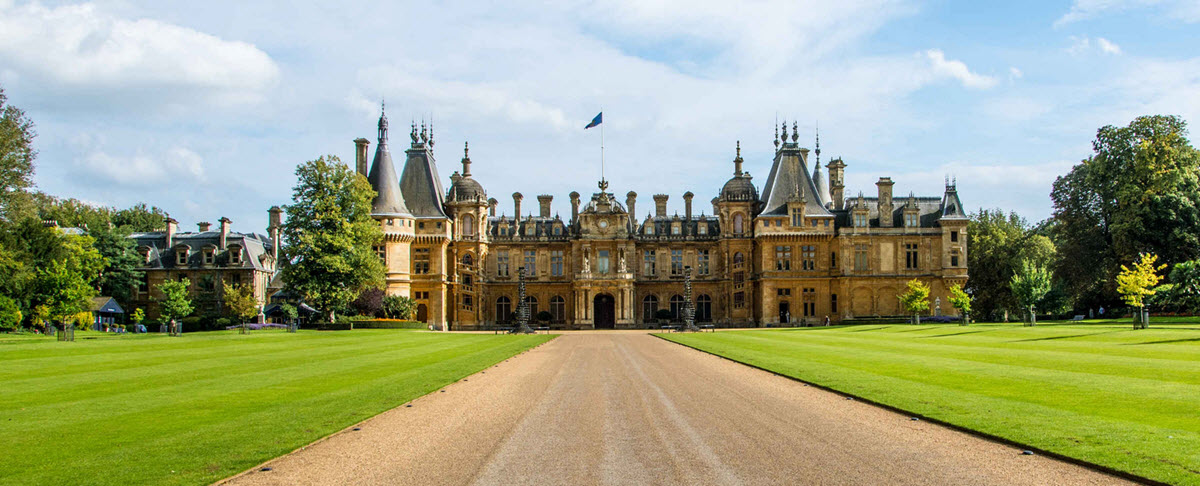Contents
Waddesdon Manor is an 19th century Neo-Renaissance country house built for Baron Ferdinand de Rotchild as a weekend residence and to house his collections.
When Baron Ferdinand died in 1898, his sister Alice von Rothschild (1847-1922) inherited Waddesdon Manor and commited herself to preserving it. The last member of the Rothschild family to own Waddeston was James de Rothschild (1878-1957) who bequeathed the house, its contents and 120 acres of grounds to the National Trust.
Waddesdon Manor opened to the public in 1959 and is today one of the National Trust´s most visited properties. Data from 2018 show that in that year, it received well over 460,000 visitors. The estate is managed by the Rothschild Foundation, chaired by Jacob Rothschild, 4th Baron Rothschild.

Where is Waddesdon Manor?
Waddesdon Manor is a part of the village Waddesdon, in Buckinghamshire, England. It is located within the Ayelsbury Vale.
Early history
Background
In 1874, the Duke of Marlborough sold an agricultural estate named Waddesdon to Baron Ferdinand de Rothschild, who paid with money inherited from his father Anselm Rothschild. At this point, it was just an agricultural estate with no house, park or garden. The spot were the impressive home would eventually be erected was simply a bare hill called Lodge Hill. It had once contained trees, but the impoverished Duke of Marlborough had sold off the timber.
Levelling the summit of Lodge Hill took three years. On 18 August, 1877, the foundation stone was finally laid down for Waddesdon House.
Creation
Ferdinand de Rotschild hired the architect Gabriel-Hippolyte Destailleur, since he wanted someone with previous experience working with the style of the large Renaissance châteaux of the Loire Valley in France. Destailleur had been involved in the restauration of several châteaux in the valley and was thus a perfect fit.
Destailleur based his design for the main towers of Waddesdon Manor on those of the Châteaux de Maintenon, while the twin staircases towers on the north side took their inspiration from a staircase tower at Châteaux de Cambord. Unlike these old Renaissance towers however, the Waddeston towers were fitted with glazed windows – a very luxorious detail at the time.
While taking inspiration from the days of yore, Destailleur also incorporated a lot of modern creations and conveniences in his creation. He did for instance utilize a steel frame in the construction, and fitted the house with central heating, an electric bell system, and both cold and hot running water.
As soon as the Waddesdon Manor was completed in 1883, Baron Ferdinand decided that he needed more rooms. Before the decade was over, the house had been extended with a Bachelor´s Wing to the east and a late-Gothic style Morning Room to the west.
https://www.youtube.com/watch?v=OxA2NvUg1jQ
Use
The first house party in Waddesdon Manor took place in May 1880, several years before the house was completed. For this inagrual celebration, Baron Rothschild invited seven of his close male friends to enjoy a fireworks display.
After the house´s completion, Baron Rothschild started using it for entertaining guests in the summer time, chiefly from May to September. He hosted many important visitors, including members of the royal family. To care for the guests, there were two dozen house staff present. When Queen Victoria visisted in 1890, she was impressed by the electric chandeliers.
Back in those days, Waddesdon Manor could spoil its guests with fruit, vegetables and flowers from its own substantial kitchen garden and glass houses. It was here that Baron Ferdinand grew his beloved orchids.
Baron Ferdinand also set up a little livestock area where his guest would be taken to drink fresh milk from cows who wore Meissen porcelain name tags.
In 1889, a cast-iron aviary was completed on the manor grounds, and Baron Ferdinand stocked it with exotic birds. The aviary was inspired by 18th-century pavillions at the Palace of Versailles and Chateau de Chantilly, and Ferdinand’s childhood home in Grüneburg. (Nowadays, the aviary is a registered zoo and a breeding program is in place for endangered species.)
